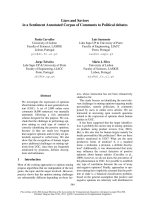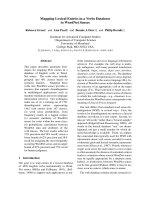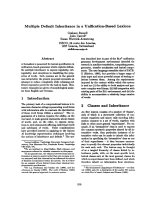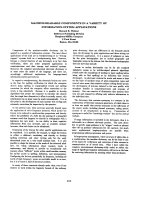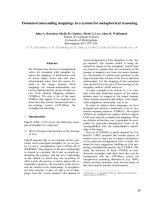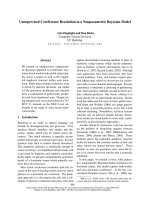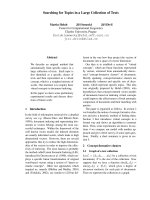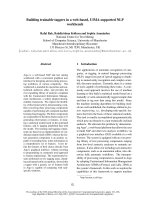báo cáo khoa học: "Coronary artery surgery in a man with achondroplasia: a case report" ppsx
Bạn đang xem bản rút gọn của tài liệu. Xem và tải ngay bản đầy đủ của tài liệu tại đây (249.72 KB, 2 trang )
CAS E RE P O R T Open Access
Coronary artery surgery in a man with
achondroplasia: a case report
Georgios I Tagarakis
*
, Dimos Karangelis, Andony J Baddour, Nicholas Desimonas, Angeliki Tsantsaridou,
Marios E Daskalopoulos, Dimitrios Papadopoulos, Nikolaos B Tsilimingas
Abstract
Introduction: Achondroplasia is a musculoskeletal disorder associated with short stature. Despite an estimated
prevalence of 1:25,000 in the general population, there is little literature concerning the diagnostic and treatment
challenges faced by doctors dealing with a heart operation on a patient with this condition.
Case presentation: We present the case of a 41-year-old Caucasian man of Greek ethnicity with achondroplasia,
who underwent bypass heart surgery.
Conclusions: The surgery was successful and did not present particular difficulties, showing that heart surgery can
be safely performed on people with achondroplasia.
Introduction
Dwarfism is a term referring to people of short stature,
and can be due to several musculoskeletal and h ormonal
growth disorders. The most common cause is considered
to be achondroplasia, a morbid condition due to a muta-
tion affecting the fibroblast growth factor receptor (FGFR)
gene 3. Despite an estimated prevalence of 1:25,000 in the
general population [1], little has been written on the diag-
nostic and treatment challenges faced by d octors with
achondroplasia patients who require heart surgery. We
report here a thir d case con cerning dwarfs and heart
surgery and the second dealing with dwarfs and bypass
heart surgery [2,3].
Case presentation
A 41-year-old Caucasian ma n of Greek ethnicity with
achondroplasia was referred to our cardiothoracic sur-
gery department following coronary a rtery angiography
and a diagnosis of t hree-vessel coronary artery disease.
Angiography was perf ormed d ue to m ild angina l symp -
toms dating about four months prior to the examination.
Interestingly, our patient lacked any predisposing risk
factors, including burdening family history, with the
exception of a borderline arterial blood pressure of 135
to 140/85 to 90 mmHg. His lipidological/biochemical
profile included the following values: total serum cho les-
terol 190 mg/dL, LDL (low density lipoprotein) choles-
terol 148 mg/dL, HDL (high density lipoprotein)
cholesterol 45 mg/dL, creatinine phosphokinase 100 U/L,
creatinine phosphokinase-MB 7 U/L. Due to the short
stature of our patient (137 cm height, 45 kg weight) and
the disproportionate skeletal growth (short limbs, normal
size thorax, big head), we performed a phlebography of
the limbs to check the status of possible saphenous vein
grafts, which proved to be normal. Our patient was also
submitted to routine pre-operative control and scheduled
for an elective on pump coronary artery bypass graft
(CABG) operation. The official indication for the surgical
revascularization of our patient was based to his three-
vessel disease, which included a 90% stenosis of the prox-
imal left anterior descending artery, a 70% stenosis of the
proximal obtuse marginal artery and a 90% stenosis of
the right coronary artery. Both echogardiography and
ventriculography revealed no additional pathologies, with
a left ventricular ejection fraction of 65%.
At surgery, anatomical conditions in the thorax
appeared normal and a triple on-pump bypass operation
with one a rterial (left internal mammary artery to left
anterior descending artery) and two venous (vena saphena
magna) grafts (to the first obtuse marginal branch and the
right coronary artery before the crux) was performed with-
out any problems, with anesthetic and cardioplegic adjust-
ments (St. Thomas cardioplegic solution at 32°C) made
* Correspondence:
Department of Cardiovascular and Thoracic Surgery, University Hospital of
Thessaly, Larissa, Greece
Tagarakis et al. Journal of Medical Case Reports 2010, 4:348
/>JOURNAL OF MEDICAL
CASE REPORTS
© 2010 Tagarakis et al; licensee BioMed Central Ltd. This is an O pen Access article distributed under the terms of the Creative
Commons Attribution License ( .0), which permits unrestricted use, distribution, and
reproduction in any medium, provided the original work is properly cited.
only to fit the patient’ s body mass index and weight. The
patient had a flawless postoperative course and w as dis-
charged from the clinic on the tenth post-operative day.
Follow-up contr ols one week, one month and six
months after discharge revealed no pathologies and our
patient was objectively and subjectively well.
Discussion
A first issue to be addressed is the fact that a young
patient with achondroplasia developed operation-
indicat ed coronary artery disease without detectable risk
factors. Does this maybe mean that occult genetic or
other factors in patients with dwarfism might lead to
vascular morbid situations, such a s coronary artery dis-
ease, or was this a random event? The matter warrants
further investigation, as our patient is, to the best of our
knowledge, only the second in the medical literature,
and as a result little experience has been gathered.
The second issue is that dwarfs with achondroplasia
can safely undergo heart surgery with analogical adjust-
ments made accordingly to the patient’ s body mass
index and weight.
A third issue is the small number of case reports deal-
ing with this subject. Are people with dwarfism less fre-
quently submitted to heart surgery than the general
population? If this is the case, are there any medical rea-
sons for that or must we search for other causes, such
as the fear of doctors to deal with such patients due to
lack of experience or the social exclusion of dwarfs in
some societies, for example.
Conclusions
Heart surgery can be safely performed on patients with
dwarfism due to achondroplasia, despite the fact that lit-
tle information dealing with this issue is available in
international literature. It is interesti ng that only a small
number of similar reports have been published.
Consent
Written informed consent was obtained from the patient
for publicatio n of this case report and any accompany-
ing images. A copy of the written consent is availabl e
for review by the Editor-in-Chief of this journal.
Authors’ contributions
GT was the primary surgeon of this case, made a thorough literature review,
and was the chief author in terms of developing the paper. DK performed a
consultation regarding anti-reflux treatment, and co-authored the paper. AB
was the attending surgeon of the case and checked the paper. ND assisted
with the linguistics and performed a literature research. AT performed
literature research. MD checked the final version of the manuscript. PD
assisted with the literature research. NT was the attending surgeon. All
authors read and approved the final manuscript.
Competing interests
The authors declare that they have no competing interests.
Received: 29 Jan uary 2010 Accepted: 29 October 2010
Published: 29 October 2010
References
1. Wynn J, King TM, Gambello MJ, Waller DK, Hecht JT: Mortality in
achondroplasia study: A 42-year follow-up. Am J Med Genet 2007,
21:2502-2511.
2. Balaquer JM, Perry D, Crowley J, Moran JM: Coronary artery bypass
grafting in an achondroplastic dwarf. Tex Heart Inst J 1995, 22(3):258-260.
3. Neema PK, Sethuraman M, Vijayakumar A, Rathod RC: Sinus venosus atrial
septal defect closure in an achondroplastic dwarf: anesthetic and
cardiopulmonary bypass management issues. Pediatr Anesth 2008,
18(10):998-1000.
doi:10.1186/1752-1947-4-348
Cite this article as: Tagarakis et al.: Coronary artery surgery in a man
with achondroplasia: a case report. Journal of Medical Case Reports 2010
4:348.
Submit your next manuscript to BioMed Central
and take full advantage of:
• Convenient online submission
• Thorough peer review
• No space constraints or color figure charges
• Immediate publication on acceptance
• Inclusion in PubMed, CAS, Scopus and Google Scholar
• Research which is freely available for redistribution
Submit your manuscript at
www.biomedcentral.com/submit
Tagarakis et al. Journal of Medical Case Reports 2010, 4:348
/>Page 2 of 2
